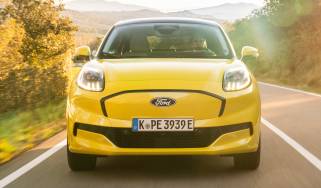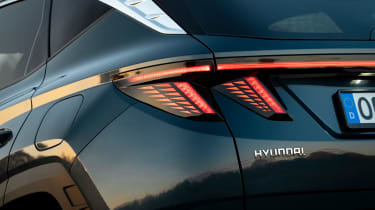Hyundai Tucson: old vs new
Hyundai’s family SUV has received a bold makeover but how does it compare to the previous Tucson?
Some cars don’t look that different from one generation to the next but that’s not a criticism you can level at the Hyundai Tucson. What used to be a smart but humdrum SUV is now an eye-catching car that looks like nothing else on the road. The innovation is more than just skin-deep, with hybrid powertrains and the latest interior tech.
The Tucson sits between the Hyundai Kona and Hyundai Santa Fe in the Korean brand’s SUV lineup, and rivals the Peugeot 3008, Ford Kuga, Skoda Karoq and Kia Sportage. We expect plenty of buyers to go for the Hyundai on looks alone, and existing Tucson drivers might be keen to embrace the updates. Here’s how the new Hyundai Tucson SUV compares to the old one.
Styling
There’s nothing wrong with the previous Hyundai Tucson. It’s clearly a newer version of the old Hyundai ix35 but has a handsome design and is suitably chunky. High-set headlights and wheel arches coated in black plastic give it the look of a 4x4, and chrome embellishments are an upmarket touch. There’s also a sporty-looking N Line version (shown in these pictures), with deeper bumpers and darkened trim pieces.
You could argue that the last Tucson had slightly generic styling, which is emphasised by the new car. It looks like it’s been dropped from another planet, with its bold front end and deep slashes and creases on every panel. When the car is parked up, the block of LED lights becomes invisible, so it looks like an extension of the grille. The rear end gets a full-width lightbar connecting intricate vertical tail-lights. We think it’s even more interesting to look at than the Kona or Santa Fe, and both of those stand out in a car park.
Interior
Hyundai favoured a logical layout for the previous Tucson, so everything is close to hand and easy to get to grips with. It still looks modern inside, especially on the facelifted model with a free-standing touchscreen, and you get an impressive amount of standard equipment. DAB radio, a reversing camera and leather-trimmed touchpoints are all thrown in across the range. The touchscreen is a little dated and cluttered but you can sidestep it if you wish, as Apple CarPlay and Android Auto come as standard.
In the latest model, the sweeping dashboard layout isn’t a million miles away from an expensive Land Rover SUV. The centre console features a 10.25-inch touchscreen with fresh new graphics, while a screen measuring the same size is another new addition in front of the driver. It looks like a tablet perched there, as there’s no cowl or covering - going without makes the interior feel even more spacious. Spec highlights include three-zone climate control, a Rear Sleeping Mode (which turns down the speakers in the back) and online connectivity through Hyundai’s phone app.
Practicality
There’s plenty of room for a family and all their paraphernalia in the Tucson, which is quite important in this class of car. You won’t find as many handy storage cubbies as you’d find in a purpose-built MPV but the Tucson’s back seats are very spacious and entry is easy thanks to wide-opening doors. The 513-litre boot (459 in four-wheel-drive models) is competitive, not to mention a good shape.
Some rivals are more practical, which explains why the new Tucson has grown in pretty much every direction. Thanks to a slightly longer distance between the front and rear wheels (the wheelbase), there’s 26mm extra legroom, while all three seatbacks now fold individually. Keep them in place and you’ve still got between 546 and 620 litres of boot space to fill, depending on which engine you choose.
Engines
In the recently replaced Hyundai Tucson, you could choose from three diesel engines and two petrol units. All except the most powerful diesel are 1.6 litres in size, which means acceleration isn’t the car’s strong point. There’s not too much steering feel but the car is comfortable over bumps and reasonably good to drive.
The 134bhp diesel engine is carried over but it seems at odds with the Tucson’s futuristic feel. For something a little more modern, you might want to take a look at the mild-hybrid petrol engine or the ‘full’ hybrid version, which should offer diesel-like efficiency with a brisk eight-second 0-62mph time.
Verdict
The outgoing Hyundai Tucson is quite good value and it doesn’t let itself down in any area. Prices haven’t been announced for the new model at the time of writing but it’ll need to be substantially more expensive to stop us recommending it. The new car is a real glimpse of the future and a marked improvement over its predecessor. We won’t be too surprised if the new Tucson ends up as one of the best-selling cars in the UK.
Read about our current favourite family SUV, the Peugeot 3008, or check out some of the best hybrid SUVs on sale now.
Recommended

New Subaru Trailseeker revealed as rugged electric SUV with 375bhp

New Subaru Solterra brings more range, power and polish
Most Popular

Omoda E5 targets rivals: now with zero deposit and APR

Ford Puma Gen-E driven: Electric charmer or too little, too late?
Tips & advice

Car dashboard warning lights: what does each symbol mean?

Electric car charging stations: public networks, charger types, apps and maps
















